

The Chain Splice is a useful way of attaching a line to a chain so that it can pass through a windlass without binding.
Anchoring Book
Happy Hooking, the Art of Anchoring, a book about anchors and anchoring.
Anchor rollers and other ways of securing your anchor on your boat
Anchoring Videos
The Boating Guy video about different types of anchors and required rode lengthUnderwater footage of how a Manson Supreme Anchor sets in sand
BoaterExam has video on anchoring
Another BoaterExam video on anchoring
West Marine Talks about Danforth type of Anchor
Cheap anchor float, Amazon add-on product:
Anchor Links
Good Article in Yachting Monthly on how to choose an anchor.Anchor Buddy, a weight system that claims to improves setting Youtube Video
Fortress anchor aluminium Danforth style anchors
Kingston Anchors
Lewmar, has CQR, Delta and Claw anchor types.
Plastimo supplies Kobra© Anchors.
Super Max Anchors
Rocna Knowledge base project
Spade Anchor can be used with less rode French design.
New Zealand Coast guard recommends Rocna Anchors. (PDF)
Rocna CMP group test anchors pdf document
Bullwagga Anchors are good in weeds and rocks
Rocna Anchors have great reputation
Mantus Anchors Multipurpose anchor for Hard and grassy areas.
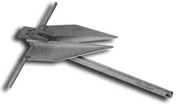
Danforth Style fluke anchor

Plow or CQR anchor

Delta plow anchor type
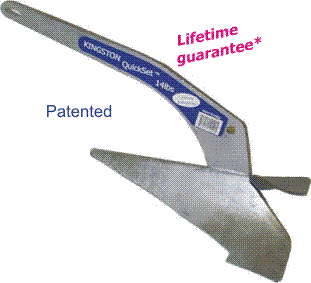
Quickset anchor

Kobra

Spade anchor
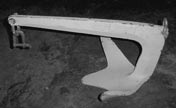
Bruce or Claw anchor

Supermax anchor
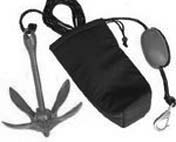
Grapnel anchor style

Heavier Grapnel folding anchor

Mushroom anchor

River anchor
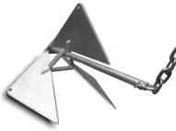
Bulwagga anchor

Kedge anchor
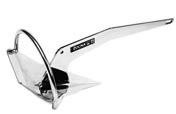
Rocna anchor
Rocna ROCORG010GS, Galvanized Anchor 22 lbs, 10 kg Amazon link

Navy anchor

Hydro Bubble anchor

Mantus Boat Anchor
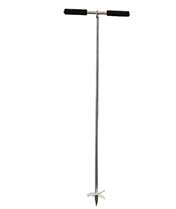
Sand Anchor
Extreme Max 3006.2258 BoatTector Double Braid Nylon Anchor Line with Thimble - 1/2" x 150', White & Gold

XYZ Boat Supplies 316 Stainless Steel D- Shackle R

Extreme Max 3006.6578 BoatTector Anchor Chain - 1/4" x 4' Stainless Steel with 5/16" Shackles

Anchors
The value of having an anchor was driven home to me the day I started my motor to get out of harbour for the first sail ever in my new (for me) Tanzer 22.The motor mount plate broke sending my motor down and leaving me drifting towards fancy yachts, then beaching, in strong winds. (Luckily my motor was tied to the railing so it did not go swimming) Story here
Also luckily I had an anchor ready to set. This stopped the drift and gave me time to calm down and get help.
Even if you are not planning to throw your outboard overboard, or to actually anchor your boat, having one all set up and ready to go is a major source of security on.
Heavy or Light Anchor Style?
Anchors work in 2 ways, either they are massive and use their weight to keep the boat from drifting, OR as in most modern sailing yacht anchors types, they are relatively lightweight and bury themselves in the bottom to stop the boat from moving. Some anchors are now being made of aluminium and rely almost entirely on their shape for their function.
Sea Anchors and Drogues
What do you do when its too deep to use a regular anchor? Use a Sea Anchor or a Drogue. Read all about these on my Sea Anchors and Drogues page, and in my Useful articles about Drogues and Sea Anchors
Some Terms Related to Anchors and Anchoring
- Ground Tackle
- Collectively, all the rode, shackles and anchor used to anchor a boat.
- Rode
- The chain, rope, cable, or a combination of these that attaches to the anchor.
- Scope
- A ratio of the length of rode to the depth of the water.
- Up and down
- An anchor chain is up and down when the boat is directly above the anchor and the chain is no longer lying on the bottom.
- To weigh anchor
- To take on the weight of the anchor on the boat, to lift the anchor from the sea floor. Similar to Anchors Aweight (not anchors away!)
- An anchor is broken off or broken out of the bottom
- When it is lifted off the bottom.
- Come home
- To Drag
- Set
- To drop and position an anchor so that it holds
- Changing the NIP of the anchor line
- To prevent wear at the same place the anchor line is occasionally let out or taken in so that chafe is not always on the same spot on the rode.
- Tripping an Anchor
- A tripping line is attached to the opposite end of the anchor. This line is used to pull the anchor out if it is caught or fouled.
- Horizontal Load
- The force exerted on an anchor by the boat pulling horizontally.
- Vertical Load
- The force exerted on the bow of a boat by the anchor rode.
- Hawsepipe
- A pipe or moulding in a boats side where the anchor rode fits through the hull.
Anchor Types for Keel Boats
| ANCHOR TYPE | Type of Bottom | How Does it Work | Other info |
| Danforth or Fluke also called Light weight | Best in Clay, Sand and Mud | The anchor lands on the bottom flat on its side. The rod like stock extend on both sides to keep the anchor from rotating and the flat crown pieces keep the flukes in position. The anchor gradually buries itself. Can come undone if there is a large shift in the direction of pull from the boat such as in tide change. If the bottom does not allow for digging in such as hard or rocky, or weedy, then the flukes can't bury and the anchor will not set. |
Mostly high strength steel galvanized or stainless. Marine Now 8.5 pounds anchor with chain and rode.
There are also aluminium versions: GUARDIAN ANCHOR BOATS 23-27 feet. From Tie Down Engineering:DANFORTH STANDARD ANCHOR 8S |
| Plow or CQR "se_cu_re" | Sand and stiff Mud, Grass pebble can hold in coral, less good in soft mud or clay. | When the plow anchor first lands, it is on its side but as it gets pulled the anchor rights itself and gradually plows into the bottom. It buries itself and holds well. Because this anchor type swivels horizontally on a hinged shaft, it resists pulling out when the direction of pull changes as when the boat shifts because of tide change. The CQR is a robust anchor often chosen by blue water cruisers as a storm anchor. | Plow anchors are bulkier to store than Danforth anchors. The hinge can get fouled and blocked and this can cause the Plow anchor to not set properly and drag or worse pull out. It is more effective in harder ground than the Danforth type anchor. Easy to pull up with a vertical pull. NEW SEACHOICE 22 LB PLOW ANCHOR SCP 41550 |
| Delta, Quickset, Spade, Kobra | Similar to CQR | See Plow Above. These anchors do not have swivel hinge but weight help them set. The Delta anchor style has the reputation of having stronger holding power than the Plow/CQR. Quickset Anchor has small fins that help position and stabilize the anchor. Spade anchor plows into seafloor and because of concave shape compacts the floor. Available in steel, SS, and Aluminium. |
Heavier and bulkier than Danforth anchors. Not having the hinge makes them easier to handle. Also makes them less expensive. Because of the shape of the plow and delta anchor it is easier to store at the bow of a boat rather than in a locker. Easy to pull up from straight overhead. Lewmar anchor link: Lewmar Galvanised Delta Anchor, 10 kg/22 lb. |
| Bruce or Claw, M-Anchor | Sand or Mud, not ideal for rock | These anchor types were designed for oil rigs in the North Sea. Smaller versions have found happy customers on yachts and boats everywhere. Because of the design, the Bruce or Claw anchor rights itself and quickly plows into the bottom. There is less likelyhood of this anchor pulling out but if it does the Bruce anchor resets quickly helped by the large claws. Useful when a short rode is necessary | Not easy to store in a locker, this anchor is happier at the bow. Easy to pull up from straight above like the other plow type anchors. Rarely it collects a rock in the claws and can't set. Lewmar claw anchor link: Lewmar Claw Anchor, 22 lb./10 kg |
| Super Max | All | Similar to other claw/plow anchor styles but has adjustable fluke angle. Not a light anchor but effective. | Larger flukes and adjustable angle means that the angle can be adjusted for different bottom conditions. This leads to better holding in soft mud which is a problem with the plow and delta types of anchor. |
| Grapnel | Coral, Stone, heavy weeds | Grapnel type anchors are useful in coral or where the flukes can grip something. Grapnel are less useful in mud or sand. Grapnel anchors are often used in dinghies or where their light weight or small size is an asset. Folding models and grapnels that come apart are available. Not for serious anchoring unless the bottom can be hooked. Sometimes useful when there is heavy vegetation and the thin flukes can penetrate while the outside ones grab vegetation. | Grapnel anchors are often seen where there is a legal requirement for an anchor but they are not likely to be used often, such as on dinghies. Tends to snag its rode at every turn! Quick Tech makes a tidy grapnel: KWIK TEK A-2 Complete Folding Anchor System |
| Mushroom Anchor, River Anchor | Silt, Mud, mushroom Permanent, river temporary | Most often used as permanent mooring anchors. This style of anchor is designed to gradually dig itself deeper and once imbedded has excellent holding ability. It usually goes down They are useful for anchoring racing marks. They do not hold very well until they are imbedded in the bottom. After imbedding they can have a holding power of as much as ten times its weight. The river Anchor is designed specifically for areas of river current where there is heavy drift conditions. The 3 blades act with a grappling action. The cut outs allow for easier pull out than the mushroom. |
The Mushroom Anchor does not work in weedy or rocky bottoms where it can't bury itself. Sea Sense anchor link: SeaSense 10lb Black Vinyl Coated Mushroom Anchor |
| Bulwagga | Weed rock sand Mud | Better performance in weeds than many other styles of anchors. Its pointy grapnel like flukes can hold on to rocks or coral. Sliding shank (with pin that can be removed) helps retrieve anchor from difficult or fouled locations. | Triangular fins means there is no position that is bad. |
| Kedge, Hereshoff, Fisherman and Yachtsman, Admiralty Pattern | Softer bottoms, hard sand, Rocks and Coral, Weeds | Used for centuries they are the traditional anchor shape we are used to. Modern kedge style anchors are lighter and have been adapted for specialized use. Sharp bills and small flukes hold better in hard sand. Broader flukes and larger arms hold better in soft bottoms or rocks and coral. Kedge anchors are often used successfully in heavy vegetation. | A more specialized anchor. When not used in specialized conditions, Kedge anchors should be heavier (sometime much heavier) than modern anchors to hold as well. |
| Rocna, Manson Supreme, Wasi, Bügelanker, Sarca, Mantus | All | This style of Anchor has a bow or roll bar that help the anchor quickly position itself to allow the spade to start digging in and helps prevents the anchor from dragging on its side or turn around up side down. Because they set quickly and hold in difficult bottoms these anchors are much appreciated. Rocna is recommended by the New Zealand Coast Guard. | Rocna brand of anchor had some growing pains with a warning sent out by West Marine about a change in metals. It seems to have Sorted itself out now. If you buy a second hand anchor this might matter. Rocna link: Rocna ROCFIS006GS 6KG Fisherman Anchor |
| Navy | All | A traditional type of anchor favoured because it easily fits into its hawsepipe against the side of ships. It relies mostly on it's heavy weight to hold. | Navy anchors are not much use in modern yachts because they need to be very heavy to be effective. They are still available as fishing anchors.Navy Coated anchor. |
| Hydrobubble | Same as plows | Hydrobubble has a buoyancy tank that helps the anchor go down in the water avoiding the fluttering that other plows and spade style of anchors have. It land in good position and start plowing in immediately. This helps it set quickly. Otherwise similar to other plows in holding and types of bottom. Can be dis-assembled and reassembled with plow inverted to be used as a beach anchor. | It has been tested and has caused some surprise because of its light weight and holding power. It is compact and fits in a locker. Azure Marine used to sell Hydrobubble anchors but I can't seem to find a proper link for them anymore. They come up second hand. They got good reviews. If anyone knows of a link let me know. |
| Sand, beach anchor, Powerpointe | Sand or soft ground | Sand or beach anchors are designed to give a firm attachment in sand. Useful when anchoring off a sandy beach. Typically a spike is driven or screwed in the sand. These are not long term anchors but can be useful. Powerpointe is used also in muddy conditions. | There is quite a range of products, from plastic screws, to fairly sophisticated systems. None are intended for heavy surf of strong current. To hold properly they must be screwed in quite deeply. 36 inch Sand Shark. Holding power is improved if you add bungee or a snubber to the system, to avoid shocks that could dislodge the anchor. |
Interpreting Anchor Tests
There are several tests comparing different styles of anchors and they offer valuable information for comparison
Keep in mind that testing conditions are very different and various anchors are better in different conditions.
Sea floor material, how the anchor is set and the depth of the anchor all come in play. The length and weight of the chain and total rode can make a great deal of difference.
Anchors of different sizes are often compared. Read the small print and look at who is comparing, they sometimes have a vested interest.
Setting an Anchor
For a more in depth anchoring article see my anchoring page.
Setting anchors can be difficult and many factors can come into play. Make sure you know how to set your type of anchor and have sufficient and proper type of rode.
Its useful to look at the charts in order to know the kind of bottom and how deep the water is, don't forget to add the height of the tide to your water depth calculations.
The recommended amount of rode (line + chain) depends on the water depth. As a general rule, your rode should be 7 to 10 times the depth of the water at high tide. If the weather is bad or the waves are higher, longer rode is better.
Since most anchors set after being dragged horizontally it is important to have enough chain to keep the pull horizontal. There are practical limits to how much chain a small yacht can carry and handle but longer is better.
To set an anchor it is dropped to the bottom, then the boat is allowed to slowly drift or slowly powers downwind or downcurrent feeding out line. Once the line is out, the boat is allowed to drag the anchor to set it. Sometimes this is done when half of the line is fed out then the rest of the line is played out.
Care needs to be taken not to pile up the chain on top of the anchor when it is dropped. This can foul the anchor and prevent it from setting.
It is important to check periodically to make sure the anchor is holding and has set properly. In particular if there is a change in the current direction such as tide change, or if the wind pushes the boat around then the anchor can be dislodged. Some gps systems have an anchor watch feature that sounds an alarm if the boat strays outside it's expected circle when anchored. Here is my GPS page
When anchoring check that your boat can safely swing around on its rode and not ground itself or bump into other boats
What about rode?
An anchor is only good if it stays connected to your boat and can actually get into proper position. Without good and sufficient rode your anchor cannot do its job.
Rode is the collective term for the chain, connectors and line that connect your boat to the anchor. Typically you will have a shackle to connect a length of chain to the anchor, then a length of chain of sufficient weight to keep the line pulling the anchor parallel to the bottom of the sea so that it can dig itself into a good holding position, then a long length of rope, at least 8 times the depth of water you intend to anchor in, connected by another shackle.
An anchor bend knot will hold a line to an anchor but the line is subject to chafing and stress and should be monitored closely and the knot moved from time to time.
Lloyd's Register of Shipping High Holding Power anchors.
These types include CQR, Bow Anchors, Delta and Danforth anchors.
This is not a complete lesson on how to anchor, get proper training!
I try to be accurate and check my information, but mistakes happen.
email me if you find mistakes, I'll fix them and we'll all benefit: Christine
Small Print
This information is for general knowledge. I don't suggest that this is the only way or the best way to anchor a boat. Use your head and do your research. Anchoring depends on the conditions as well as the type of anchor. In order to anchor well you need to know the kind of bottom you are likely to encounter and adjust your anchoring strategy to current conditions.